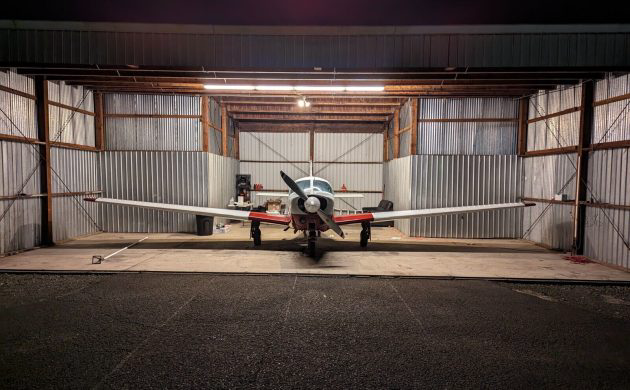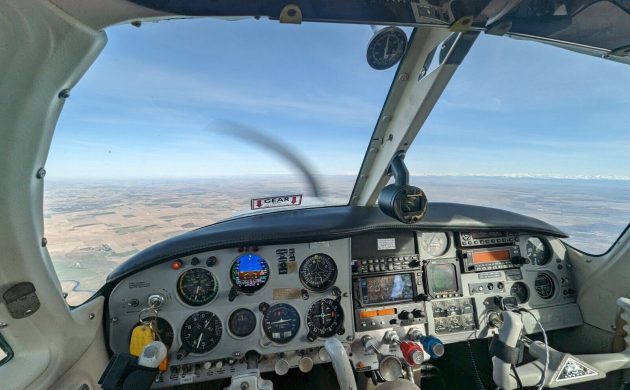
Vintage aircraft are seemingly more popular than ever before, with numerous YouTube channels springing up weekly where new owners document their purchases that allow them to take to the skies. There are thousands of forgotten aircraft languishing at small, regional airports around the country, which is a tell-tale sign of just how expensive of a hobby this can be. But for those enthusiasts that can balance the aircraft budget and the training necessary to be a safe and prepared pilot, I suspect the risks are worth the reward. This 1966 Mooney M20C is a classic model that is very popular in the private pilot community, and it’s listed here on eBay with a suggested opening bid of $55,000.

The Mooney M20 is the aircraft model that effectively put Mooney on the map. Like other startups, Al Mooney’s company lost money for several years before it began to turn a profit, and the M20 was integral in those efforts. Originally designed with a wooden wing and tail structure, the M20 was noted for its impressive speed out of the Lycoming O-320 engine and excellent cruising abilities, making it a terrific choice for long-distance trips. The seller notes his plane is in what sounds like turnkey condition, as he has used it regularly to go “…coast to coast and border to border.”

The wood tail and wing structure proved problematic, as one might expect, when wood rot occurred and those critical components to safe flight began to break apart. After a few personnel changes, Mooney transitioned to aluminum in place of wood, and the M20C – like our subject plane – was introduced shortly thereafter. The M20C featured other improvements beyond better, more durable materials, as it also featured better cooling capabilities, a lightweight floor, improved landing lights, and a revised exhaust system. In total, 336 M20C planes were sold in 1962.

The seller provides several data points highlighting recent improvements to his M20C, including the replacement of the magnetos, new landing lights, three new cylinders, LED wing lighting, a recent battery, and a fresh annual from the Mooney service center. When it comes to personal aircraft, upkeep is as important as training, along with taking the necessary steps to proactively track maintenance so there’s no doubt that the right services have occured before taking to the skies. Personally, I love vintage aircraft like this Mooney, but I don’t know about the asking price: is the opening bid a fair number?


I love these planes, and this is a beautiful example. However, in my opinion, the key here is engine and prop time. 1452 hours on both. Generally, this engine type will have a factory recommended 2000 hour time between overhauls. It looks like the plane is very well maintained, so you could have a few hundred hours of relatively trouble free operation. But, a major overhaul of a Lycoming 0-320 and a constant speed prop isn’t cheap. If I were considering buying, that future cost would have to be factored into the price. $55,000 is probably fair. It just depends on where the reserve is.
I flew Mooney’s for 15 years they are a very economical aircraft to fly. Two things the buyer needs to know and keep in mind. Realistically you have 500 hrs of flight time to prop and engine overhaul, the number given in the first post is accurate.
2. With my last Mooney I figured my cost on everything including hanger, annual, insurance, and the flight cost. I figured it cost me around 450.00 per hour to fly that plane! It was 90 percent for business so that makes all the difference!
I learned to fly in a 1967 Cessna 150, and then spent the 70’s flying USAF Lockheed EC-121 Super Constellations (none of them built before 1955). The idea of a 1966 Mooney being a “vintage aircraft” is enough to make this old guy cry.
I learned to fly (mostly) in a 172 but learned stalls and spins in a 150. There was a saying that you couldn’t spin a 172. I found out onmy test flight that a 172 spins just as easily as a 150.
A rather sad ending: one of my best friends was doing some low level photography in that same 150 that I flew on a blistering hot day. They hit a downdraft and crashed. My friend and the pilot both killed. Hard to believe, that was 35 years ago…
I had a 1948 Luscombe taildragger a long time ago. I had a mechanic lined up to work on it. But before he could, he and another pilot were killed. I think they were doing inverted flight at the time.
Luscombes were notorious for being hard to land (narrow landing gear). They would ground loop in a second.
I wondered what happened to it. Found from FAA records that the owner crashed and totaled it.
So it goes with small planes.
In 1970 I crashed in a Mooney. The plane was repairable – I wonder where it went??
And on commercial planes the pilot is always the first to the scene of the accident.
I have several hundred hours in Mooneys like this one. You wear it like a glove, but it’s very comfortable and pilot-friendly.
The Mooney I flew was an M20E, if I remember correctly. The landing gear was actuated with a huge bar between the seats. There was never any doubt whether the gear was down and locked!
Good times.
The famous Mooney “Johnson Bar”. I did some time in my dad’s ‘67 Super 21 and then later he bought a ‘70 Executive (M20E?) with electric retracts.
He later had a 1975.5 Executive then a 1981 201
The brother of a good friend had one in the ’80’s. He loved it. But told me that Mooney’s were affordable since Mooney carried no product liabliity insurance, and when sued, Mooney would dissolve and “go out of business”, but production would continue under a new corporate structure, again with no product liability insurance. So if something failed, due to design or manufacture, there was nothing to be gotten by suing.
Bob P. I am crying right along with you. When I was flying the Mooney was not vintage it was almost unobtainable for a young student pilot working on all his ratings. Flying on the GI bill there were a lot of rules. Usually a Mooney or Musketeer was only available to a student for your retractable time. Now its vintage, where did the time go ?
I always regarded a Mooney as a strange bird; someone put the tail on backwards. There were (3) Mooneys out west in our local group. One nice summer day there was a fly-in breakfast out at a local farm. The farmer had a grass strip that was short and not all that wide but he had no problems taking off and landing his Piper Comanche. A Cessna 310 and a Piper Aztec also made it with no trouble.
Back then there were few of us who had occasion to land directly into the wind; it was always Cross-wind City. In fact we used to joke about buying lottery tickets if we could set both sides of the main gear down at the same time.
One thing anyone knows about crosswinds is that if there’s a barrier on the upwind side, be it a fence, a stand of trees, or a substantial crop, a crosswind can provide a significant slipstream that would tend to draw in anything toward it. Howard’s (different Howard) air strip was no exception; there was a healthy crop of winter wheat bordering the south side of the strip.
To a high-wing aircraft a crop of winter wheat wouldn’t provide a significant slipstream but a low-wing is fair game. Regardless, you tend to keep as far away from the barrier as possible.
Well this Mooney was turning Final, and no one was particularly concerned. It was centered and remained level until it got into the ground effect and the pilot angled the plane to stay on track. As soon as he was level with the crop he practically went sideways. His portside wing hit the crop that grabbed hold and caused the Mooney to make a rather spectacular ground loop.
The pilot and hi passenger were a bit shaken but otherwise unhurt. There was some damage to the wiring and the prop but from what I heard later the guy was flying the Mooney again a few weeks later…
Any landing you can walk away from is a good landing!
When I was flying in the 1970s a friend of mine had an early M20 with wooden wings. Every time he took off he would say, “OK, guys, link arms.” One day I asked you him who he was talking to. He said, “Termites.”
Thank you for the trip down aviators memory lane
Time of operation and condition are critical for any machine, but more so for airplanes since, with very few exceptions, you have to hire an FAA licensed Airframe & Powerplant mechanic to perform maintenance and repairs. The fact that this bird passed recent airworthiness inspection is a plus, but with over 1500 hours on the Hobbs meter and a TBO of 2000 hours on the engine, things will be getting very expensive sooner rather than later. Almost anything on the airplane can be replaced on an airplane, including the wing spar (the main beam inside the wing that supports weight of the fuselage while the airplane is flying), but as always, the cost can become prohibitive. Is it worth the $55k asking price? My guess is no, because not only are you looking at an engine replacement, but verifying that the avionics support the new ADS-B requirements, and upgrading them if they don’t, also a very expensive proposition. If you do take this on, just budget accordingly, as you will be spending more money, very soon, for much more than gasoline.
My dad flew Mooney’s his entire life. He like the engineering like the chrome moly passenger cage bolted to a continuous aluminum I beam wing structure, push/pull rods instead of cables/pulleys, a very streamlined laminar flow wing. Very economical to fly, 12:1 glide ratio and like previously mentioned a very, very robust structure. My dad crashed his 1975.5 Executive into a tree 90 feet up and got it wedged in the branches. Nobody got even a scratch, him or his 2 passengers. Took several hours to secure the aircraft in the tree to rescue the occupants. He made the 6:00 ABC news in NYC in December 1981
Glad to hear that your Dad came through it unscathed. Any crash you can walk away from is a miracle. They used to tell me that even a landing can best be described as a controlled crash…
The other version of that saying is: “Any landing you can walk away from is a good landing!”, LOL!
They say walking out of the ER is a good thing too.
testing edit:
Seems like a lot of “crash” memories with these. May I remind folks, per miles traveled, flying is still the safest way to travel. You have a greater chance of getting hurt or killed ON THE WAY to the airport.
and test!
On this sale does one drive in and fly home???
Generally I always had a mechanic go over the plane prior to my arrival and give me a report on the airworthiness of it then go over any problems or concerns. If all was in order I would fly another plane to the plane I was buying with another pilot and I would then fly the new plane home and the other pilot would fly the other plane home.